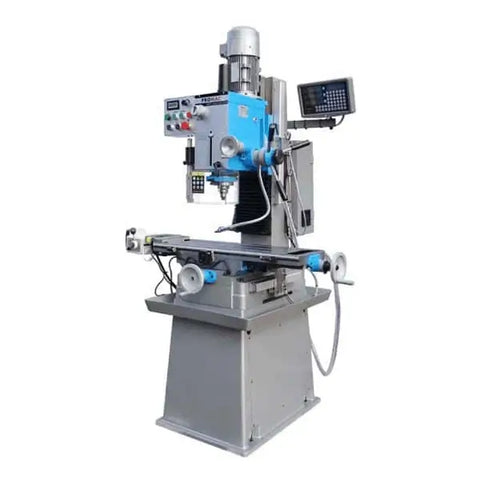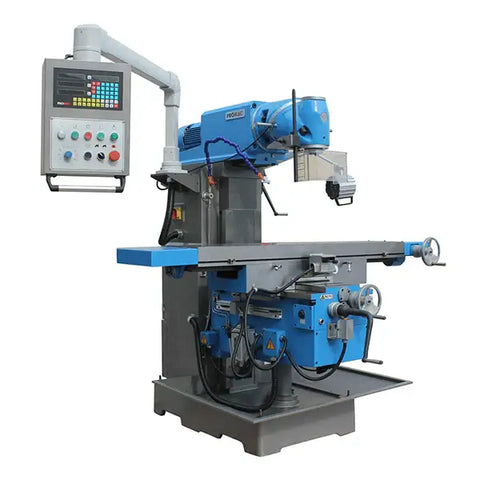
Understanding CNC Milling Machines - Your Guide
Welcome to our comprehensive guide on CNC milling machines! If you've ever wondered what these machines are and how they work, you've come to the right place. In this article, we will provide you with a clear explanation of CNC milling machines and their purpose in the machining industry.
CNC milling machines, or Computer Numerical Control milling machines, are powerful tools used to shape and create precision parts. Unlike traditional milling machines that require manual control, CNC milling machines operate using computer programs to control the movement and operation of the machine. This allows for highly accurate and efficient machining processes.
Now that you have a basic understanding of what CNC milling machines are, let's dive deeper into how they work. CNC milling machines use a rotating cutting tool to remove material from a workpiece, carving it into the desired shape. The movements of the cutting tool and workpiece are controlled by instructions from a CAD (Computer-Aided Design) file or CAM (Computer-Aided Manufacturing) software. This precision and automation make CNC milling machines incredibly versatile and ideal for a wide range of applications.

Key Takeaways:
- • CNC milling machines are computer-controlled tools used for precise shaping and machining of parts.
- • They operate using instructions from CAD or CAM software, allowing for automation and high accuracy.
- • CNC milling machines are versatile and widely used across various industries.
- • By understanding how CNC milling machines work, you can appreciate their value and potential applications.
- • Stay tuned for the next sections of this guide, where we will explore the types, applications, accuracy, and cost considerations of CNC milling machines.
Types of CNC Milling Machines and Their Applications
In this section, we will explore the various types of CNC milling machines available in the market and discuss their unique features and applications. CNC milling machines are versatile tools that are used in a wide range of industries for various machining tasks.
Vertical Milling Machines
One of the most common types of CNC milling machines is the vertical milling machine. As the name suggests, these machines have a vertical spindle axis, making them suitable for tasks that require cutting in a vertical direction. Vertical milling machines are commonly used in industries such as aerospace, automotive, and electronics.
Horizontal Milling Machines
Unlike vertical milling machines, horizontal milling machines have a horizontal spindle axis. These machines are preferred for tasks that involve cutting in a horizontal direction or require large-scale production. Industries such as construction, shipbuilding, and heavy machinery rely on horizontal milling machines for their operations.

3-Axis to 5-Axis Machines
CNC milling machines come in different configurations based on the number of axes they have. The axis refers to the direction in which the cutting tool can move. While 3-axis machines can move along the X, Y, and Z axes, 5-axis machines offer more flexibility with additional rotation around the X and Y axes. The choice of machine depends on the complexity of the part being machined and the desired precision. Industries such as medical, defense, and prototyping benefit from the capabilities of 5-axis CNC milling machines.
Now, let's take a look at some real-world examples of how CNC milling machines are used in different industries:
- In the aerospace industry, CNC milling machines are used to precisely manufacture aircraft components such as engine parts, wing sections, and landing gear.
- In the automotive industry, CNC milling machines are employed to craft intricate molds for car body panels, engine components, and interior parts.
- In the electronics industry, CNC milling machines assist in the production of circuit boards, microchips, and other delicate electronic components.
- In the medical field, CNC milling machines play a vital role in the manufacturing of orthopedic implants, surgical instruments, and prosthetics.
The versatility and precision offered by CNC milling machines make them indispensable in many manufacturing processes. They enable manufacturers to achieve high-quality results, improve efficiency, and meet strict production requirements. Let's now move on to the next section, where we will explore the accuracy and cost considerations associated with CNC milling machines.
Understanding CNC Milling Machines - Accuracy and Cost
In this final section, we will focus on two crucial aspects of CNC milling machines - accuracy and cost. Precision is a key advantage of CNC milling, and it plays a significant role in the success of any machining operation. Achieving high levels of accuracy requires careful consideration of several factors, including machine calibration and tooling.
Machine calibration is essential to ensure that the CNC milling machine operates with precision and consistency. Regular calibration ensures that the machine maintains its accuracy over time. By properly aligning the machine's axes and compensating for any deviations, operators can achieve the desired accuracy in their machining processes. Choosing the right tooling, such as high-quality cutting tools and workholding devices, also contributes to enhanced accuracy.
Let's take a closer look at the cost considerations associated with CNC milling machines. Initial investment in CNC milling machines can vary based on factors such as machine size, specifications, and additional features. While CNC milling machines can be a significant investment, their long-term benefits often outweigh the initial cost.
Maintenance and operational expenses are additional cost factors to consider. Regular maintenance ensures optimal performance and prolongs the lifespan of the machine, reducing the risk of unexpected breakdowns and costly repairs. Operational expenses include tooling costs, electricity consumption, and any software or support services required for the CNC milling process.
Now, let's summarize the accuracy and cost aspects of CNC milling machines:
| Accurate Machining | Cost Considerations |
|---|---|
|
|
By understanding the accuracy levels achievable with CNC milling machines and the associated costs, manufacturers can make informed decisions about incorporating CNC milling technology into their processes. CNC milling machines provide unmatched precision and efficiency, enabling businesses to produce high-quality parts and components consistently.

Conclusion
CNC milling machines have revolutionized modern manufacturing, playing a pivotal role in various industries. Their precision, versatility, and ability to automate complex machining processes make them powerful tools that have transformed the way products are made. By understanding the different types of CNC milling machines and their applications, as well as the factors influencing accuracy and cost, you are now equipped to fully appreciate the value they bring to manufacturing sectors.
Embrace the possibilities offered by CNC milling and explore the endless opportunities it presents for transforming your production processes. With CNC milling machines, you can achieve higher levels of accuracy, improve operational efficiency, and unleash your creativity to design intricate and intricate parts and components. Whether you're in automotive, aerospace, or any other industry, CNC milling machines can enhance your capabilities and help you stay at the forefront of innovation.
Investing in CNC milling machines is an investment in the future of your business. While there may be upfront costs and ongoing maintenance expenses, the long-term benefits far outweigh them. CNC milling machines allow you to produce high-quality parts with consistency, reduce human error, and increase productivity. They empower you to take on complex projects and meet the growing demands of the market, giving you a competitive edge.

